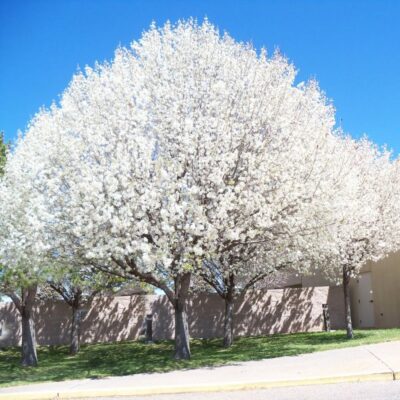Garden Plant: Aristocrat Flowering Pear
Product Description: Aristocrat Flowering Pear

Breathtaking Flowers Aristocrat Flowering Pear Tree
- Brilliant White Flowers in Early Spring
- Gorgeous Fall Color
- Tidy, Formal Profile
- Strong Branch Structure
- Versatile Small Shade Tree
What a stately, well-formed ornamental tree! With impeccable presence in the landscape, Aristocrat Flowering Pear Tree (Pyrus calleryana \’Aristocrat’) delights year round.
This fast growing, hardy, Flowering Pear tree delivers an outstanding floral display in early spring. Breathtakingly beautiful clusters of white flowers bloom on bare branches before the leaves appear. It truly is a magnificent spring show.
The spring flowers are quickly followed by bright, glossy green foliage that casts refreshing shade all growing season long. The leaves are a bit wavy at the edges, which is a subtle decorative feature in itself.
The leaves then turn a deep mix of harvest gold, scarlet red and wine dark purple in mid to late fall. This spectacular fall color is a lovely and reliable ornamental feature.
Even in winter, Aristocrat Flowering Pears are attractive. They have a stronger branch structure than their relatives, the Bradford Pear. That’s because Aristocrat won’t produce an excessive number of small shoots in between branches.
These uncluttered branch crotches make them less susceptible to damage from winter ice and strong winds. They also look far nicer when the branches are bare.
Aristocrat Flowering Pears grow with a uniform and neat canopy for a very polished look. Overall, the profile looks like a rounded pyramid.
Aristocrat root systems won’t damage concrete patios, sidewalks or driveways. In fact, with their tolerance of urban pollution, they are frequently used as street trees in areas where the Aristocrat can be sold.
Special Notes
Aristocrat is a regulated tree that performs just a bit too well in certain areas. Callery Pears may cross-pollinate if other varieties are planted nearby. Because birds love the tiny fruit, they can disperse these new hybrid Pears into the wild. Because of this, some locales have restricted their sale.
Rest assured, We use Plant Sentry to track all federal, state and local regulations on invasive materials. We will always protect you and your community. Trees are an investment in our future. We’re happy to offer this special tree for sale into areas where it will work beautifully without any concern.
To check your availability, simply type in your Zip Code to Find Your Growing Zone in the section above the Plant Highlights. Don’t miss out on your opportunity to grow this marvelous tree in your landscape!
How to Use Aristocrat Flowering Pear in the Landscape
Great for new homes, this fast-growing Flowering Pear can tolerate compacted and clay soils sometimes found in newly constructed lots.
The formal outline of the plant makes it a perfect specimen for your yard. Use a single tree at the corner of your front yard foundation planting. It will be the anchor of your design, and never outgrow it’s space or look messy.
Or, use this as a tidy frame to outline landscape features. Try this in very precise applications, such as a geometric allée marching along both sides of a long driveway.
Aristocrat has been used by many municipalities as a street tree. This is because it maintains its form without requiring pruning. It also tolerates urban sites beautifully and offers spring bloom, outstanding form, and great fall color.
It can also be used as a repeating ornamental element used as a backdrop in your backyard perennial or shrub borders.
To have a solid screen where the branches overlap and touch, plant the trees 10 feet apart.
For individual trees that will not overlap, plant the trees 15 – 20 feet apart.
Pro Plant Tips for Care
These gorgeous trees are very adaptable to most soils – including clay – but it should be well drained. If poor drainage is suspected, mound up soil 18 – 24 inches high above the native soil line. You’ll plant directly in that mound.
Give regular moisture to establish new roots in your soil. After the first few seasons, they become drought tolerant and very easy care.
Aristocrat branches can be thinned out when your tree is young, if you would like. These grow into a naturally dense canopy and thinning out the smallest branches may benefit you in the long run.
Simply decide which branches you will keep and remove the rest back to the main trunk. Be sure to keep a symmetrical profile if you do prune branches back.
While the trees are young, remove any secondary leaders that might develop. Prune after the bloom so you won’t miss a moment of the display.
This smaller tree is bedecked with ornamental features like early spring bloom, glossy green leaves and amazing fall color. No wonder it is so popular!


